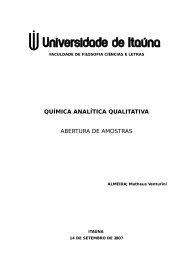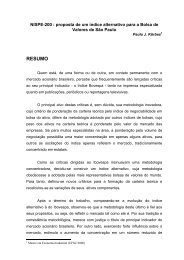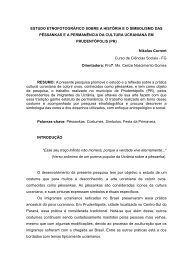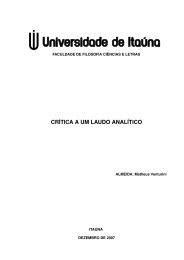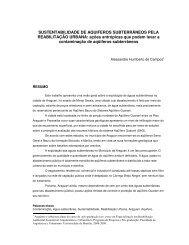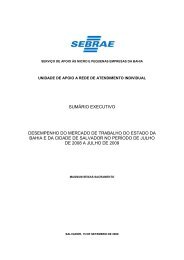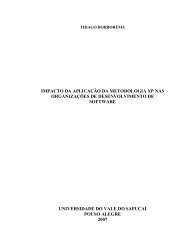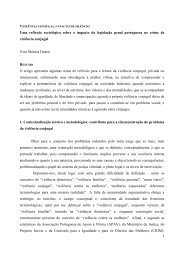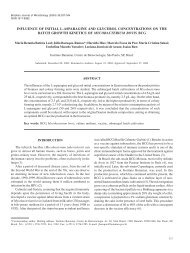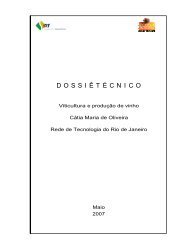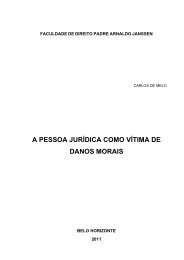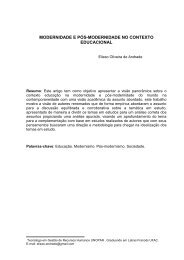Create successful ePaper yourself
Turn your PDF publications into a flip-book with our unique Google optimized e-Paper software.
Vol. 20, No. 4: 144–150 Czech J. Food Sci.<br />
Lipid Oxidation and Quality Parameters of Sausages Marketed Locally<br />
in the Town of Săo Paulo (Brazil)<br />
Abstract<br />
Sausages are the most important meat product consumed<br />
by the Brazilian population, contributing 1.7% to<br />
the total energy intake (MONTEIRO et al. 2000). In 1986,<br />
Brazilian industry produced about 25 000 tons of sausages.<br />
In 1993, 55 000 t were produced, and 45 000 t in the<br />
state of Săo Paulo alone (ANONYMOUS 1994; GONÇALVES<br />
1995; SILVA 1995). Between 1994 and 1995, there was a<br />
45% increase in the sausage production (SILVA 1995).<br />
There are many factors that interfere with the food quality.<br />
Ingredients, food manufacturing, errors or prohibited<br />
alterations in the composition, a high concentration of<br />
mechanically deboned poultry meat, wrong marketing practices<br />
and poor refrigeration constitute some of these factors<br />
(PEARSON et al. 1977; HSU et al. 1977; DAWSON &<br />
GARTNER 1983; DONNELLY & ROBINSON 1995; FERRARI<br />
& TORRES 2000a, b).<br />
144<br />
CARLOS KUSANO BUCALEN FERRARI and ELIZABETH A. F. S. TORRES<br />
Department of Nutrition – Faculty of Public Health, University of Săo Paulo,<br />
Săo Paulo, Brazil<br />
FERRARI C.K.B., TORRES E.A.F.S. (2002): Lipid oxidation and quality parameters of sausages marketed locally in the<br />
town of Săo Paulo (Brazil). Czech J. Food Sci., 20: 144–150.<br />
Lipid oxidation constitutes one of the most important causes of the chemical deterioration of foods, especially meats. Many<br />
harmful effects on human health are associated with lipid oxidation. During a period of six weeks, samples were bought at random<br />
on city hall food markets (CHFMs) and were analysed for lipid oxidation (TBARS-test) and some quality factors – redox<br />
potential (Eh), pH and water activity (a w ). The mean of Eh was X ± σ n–1 = 39.03 ± 26.30 mV, ranging from –86.00 to 92.00 mV.<br />
pH mean value was X ± σ n–1 = 5.97 ± 0.27, ranging from 5.08 to 6.48. Comparing the CHFMs, no statistically significant<br />
differences were observed between them in respect to pH, Eh, and a w values. TBARS mean value was X ± σ n–1 = 0.44 ± 0.23 mg/kg,<br />
ranging from 0.38 ± 0.19 mg/kg (CHFM-6) to 0.58 ± 0.31 mg/kg (CHFM-2), with extreme values of 0.22 mg/kg and 1.08 mg/kg.<br />
No statistically significant correlations between TBA test values and all tested variables were detected. According to the sensorial<br />
analysis criteria of GREENE and CUMUZE (1981), 16.67% of sausage samples could be rejected and 11.11% revealed critical<br />
TBARS values.<br />
Keywords: lipid oxidation; sausages, meat; food market; quality factors<br />
Abbreviations: a = water activity; CHFMs = City Hall Food Markets; Eh = redox potential; MDA = malonaldehyde; SP = State<br />
w<br />
of Săo Paulo; TBARS = thiobarbituric-acid reactive substances<br />
The association of these factors with other problems<br />
that produce an elevation of thermal energy and food oxygenation<br />
induce lipid oxidation reactions (KANNER 1994;<br />
DONNELLY & ROBINSON 1995; RHEE 1988). Other factors,<br />
such as pH, a w , Eh, and food packaging procedures<br />
could also be associated with lipid oxidation in foods<br />
(CHEN & WAIMALEONGORA-EK 1981; TORRES et al. 1994;<br />
WANG et al. 1995).<br />
Lipid oxidation of unsaturated fatty acids is initiated by<br />
the abstraction of hydrogen in carbon adjacent to the<br />
unsaturated bound. The reaction continues by the propagation<br />
step that is characterized by decomposition of<br />
unstable peroxides and finally results in the production<br />
of stable lipid oxidation products of the termination step<br />
(RHEE 1988; KANNER 1994; DONNELLY & ROBINSON<br />
1995).<br />
Supported by Grants from “Fundaçăo de Amparo ŕ Pesquisa do Estado de Săo Paulo” – FAPESP (No. 944848-2/95-5757-2), and<br />
“Conselho Nacional de Desenvolvimento Científico e Tecnológico” – CNPQ.
Czech J. Food Sci. Vol. 20, No. 4: 144–150<br />
Most of the toxic products are formed in the termination<br />
step. Aldehydes (malonaldehyde, hydroxynonenal,<br />
hydroxyhexenal), ketones, hydrocarbons, epoxides, alcohol,<br />
and other organic molecules are formed (PEARSON et<br />
al. 1983; ESTERBAUER et al. 1991; KUBOW 1992; FERRARI<br />
1998a). The presence of these compounds in foods is associated<br />
with warmed-over flavour ( TIMS & WATTS 1958;<br />
PEARSON et al. 1977) and other food sensory alterations<br />
(GREENE & CUMUZE 1981), in addition to their marked<br />
relations to the pathogenesis of cardiovascular diseases<br />
(especially atherosclerosis), diabetes, nutritional disorders,<br />
cancer and other pathologies (PEARSON et al. 1983; ES-<br />
TERBAUER et al. 1991; KUBOW 1992; FERRARI 1998a, b,<br />
1999, 2000).<br />
The aim of this paper was to evaluate lipid oxidation (by<br />
the TBA test) and its possible correlation with food quality<br />
parameters (Eh, pH, and a w ) in sausages sold on City<br />
Hall Food Markets, known as “sacolões”, in the town of<br />
Săo Paulo, Brazil.<br />
MATERIALS AND METHODS<br />
Samples<br />
During six consecutive weeks, six CHFMs marketing<br />
sausages were visited and thirty-six food samples were<br />
collected (n = 36). These methodology was important to<br />
verify that sausages were sold uninterruptedly, not only<br />
during that time period. Each sample weighing 250 g was<br />
collected in random by the food handler. With the exception<br />
of CHFM-6, which sold only poultry meat sausages,<br />
all CHFMs marketed Frankfurter sausages. It was not possible<br />
to assess the sausage producers because CHFM<br />
sellers can freely choose them, in view of low prices and<br />
availability (although the majority had chosen “Aurora’s”<br />
company). The geographic distribution of CHFMs is represented<br />
in Table 1 (FERRARI 1998b). All experiments described<br />
below were carried out in triplicates.<br />
2-thiobarbituric acid test (TBA-test)<br />
The TBA-test determines the contents of malonaldehyde<br />
(MDA), 1,3-dicarbonyl aldehyde (C 3 H 4 O 2 ) and oth-<br />
Table 1. Geographic distribution of City Hall Food Markets*<br />
of Săo Paulo (SP), Brazil, selected for sample collection<br />
Town region Locality Total per region<br />
North Vila Maria Alta 1<br />
West Butantă Joăo Moura Rio Pequeno 3<br />
Central Barra Funda Bela Vista 2<br />
Total 6<br />
Source: Diretoria dos Sacolões da Secretaria Municipal do<br />
Abastecimento (SEMAB), Săo Paulo – 1997<br />
*These CHFMs are called “sacolões”<br />
er 2-thiobarbituric acid reactive substances (TBARS) in<br />
foods. In the reaction between two TBA acid molecules<br />
and one MDA molecule, a red pigment is formed and detected<br />
spectrophotometrically by absorption of 530–532 nm.<br />
The distillation method developed by TARLADGIS et al.<br />
(1964) was used with some modifications (KUBOW 1992;<br />
TORRES et al. 1994; TORRES & OKANI 1997). Briefly, 10 g<br />
of sample and 50 ml of distilled water are put in a beaker<br />
and homogenized by virts for two minutes. The homogenate<br />
is transferred to a Kjeldahl flask. Subsequently, 47.5 ml<br />
of distilled water, 2.5 ml of HCl (4 mol/l), some anti-foaming<br />
drops, some glass beads, and 2 ml sulfanilamide solution<br />
(0.5% in 20% HCl solution) are added. The mixture is<br />
then distilled under intensive heating until 50 ml of distillate<br />
is collected in an Ernlemeyer flask. The flask is agitated.<br />
5 ml aliquots are then withdrawn and transferred to<br />
test tubes to which 5 ml of 2-TBA solution (0.02 mol/l) are<br />
futther added. The test tubes are closed and heated in a<br />
water bath at 96°C for 35 min. After cooling, absorbance<br />
at 532 nm is read using an UV-vis spectrophotometer<br />
(CE1020 model, Cecil – UK).<br />
Determination of redox potential (Eh) and pH<br />
Both Eh and pH were measured with a portable potentio-meter<br />
containing KCl electrode that was calibrated at<br />
two points (pH = 4.0 and pH = 7.0) according to the book<br />
of instructions (FERRARI 1998b).<br />
Determination of water activity (a w )<br />
a w was measured by an automatic analyzer equipment<br />
developed by Aqualab-Decagon Devices Inc., model CX-2<br />
(Washington/USA). a w was expressed by the ratio of the<br />
pressure of food water vapour to the pure water vapour<br />
pressure (FERRARI 1998b).<br />
Planning and evaluation of experiments<br />
Parametric and non-parametric tests were used to evaluate<br />
the variables in the selected places and during the<br />
determined period of time. To evaluate possible correlations<br />
between the variables studied, SPSS 7.5.1 program<br />
for Windows was used.<br />
RESULTS<br />
TBARS values of CHFM sausages (mg TBARS/kg sample)<br />
Table 2 presents the TBARS values of sausages marketed<br />
on CHFMs of the town of Săo Paulo. The mean of<br />
TBARS was X ± σ = 0.44 ± 0.23 mg TBARS/kg of sample.<br />
n–l<br />
The values ranged from 0.38 ± 0.19 mg TBARS/kg (CHFM-6)<br />
to 0.58 ± 0.31 mg TBARS/kg (CHFM-2), with limits of<br />
0.22 mg TBARS/kg and 1.08 mg TBARS/kg. The results<br />
of the analysis of variance and Kruskal-Wallis test (ANO-<br />
VA) (χ2 = 3.37; P = 0.6423) did not reveal any statistically<br />
significant differences.<br />
145
Vol. 20, No. 4: 144–150 Czech J. Food Sci.<br />
Table 2. TBARS values (mg of TBARS/kg of sample) of sausages marketed on six City Hall Food Markets of Săo Paulo*<br />
Week Locality<br />
1 2 3 4 5 6<br />
Mean<br />
Standard<br />
deviation<br />
1 0.32 0.39 0.23 0.46 0.58 0.35 0.39 0.12<br />
2 0.28 1.06 0.43 0.23 0.36 0.76 0.52 0.32<br />
3 0.31 0.88 0.56 0.25 0.22 0.38 0.43 0.25<br />
4 0.30 0.42 0.26 0.96 0.52 0.25 0.45 0.27<br />
5 1.08 0.30 0.39 0.42 0.43 0.26 0.48 0.30<br />
6 0.34 0.47 0.54 0.44 0.35 0.29 0.41 0.10<br />
Mean 0.44 0.58 0.40 0.46 0.41 0.38<br />
Standard deviation 0.31 0.31 0.14 0.26 0.13 0.19<br />
CHFMs: 1 – Vila Maria Alta; 2 – Barra Funda; 3 – Rio Pequeno; 4 – Joăo Moura; 5 – Bela Vista; 6 – Butantă<br />
*The samples were analysed in triplicate<br />
Redox potential (Eh) of CHFMs sausages<br />
The results of Eh for CHFMs sausages are shown in<br />
Table 3. Eh mean was X ± σ n–l = 39.03 ± 26.30 mV. The<br />
mean values of Eh ranged from 17.33 ± 51.78 mV (CHFM-3)<br />
to 56.67 ± 25.70 mV (CHFM-1) with extreme values of<br />
–86.00 to 92.00 mV.<br />
In the analysis of variance no statistically significant<br />
differences were observed. Kruskal-Wallis test did not<br />
reveal any statistically significant differences between the<br />
Eh means of six CHFMs (χ 2 = 3.14; P = 0.6785).<br />
pH<br />
The mean pH values ranged from 5.72 ± 0.47 (CHFM-1)<br />
to 6.13 ± 0.21 (CHFM-4), with the mean equal to X ± σ n–l =<br />
5.97 ± 0.27, with lower pH value 5.08 and higher pH value<br />
6.48.<br />
Kruskal-Wallis test resulted in a χ 2 of 7.53, with P = 0.1839,<br />
revealing that there existed no statistically significant<br />
146<br />
differences between the values of each CHFMs. The same<br />
results were obtained by the analysis of variance.<br />
The pH values of sausages marketed on six CHFMs are<br />
given in Table 4.<br />
Water activity (a w )<br />
Although a w ranged from 0.95 to 0.99 values c ± σ n–1 =<br />
0.97 ± 0.01, there were no statistically significant differences<br />
in the analysis of variance (Table 5). The χ 2 of<br />
Kruskall-Wallis was 6.98, with P = 0.2219.<br />
Statistical tests for possible correlations between<br />
quality parameters<br />
To verify possible correlations between the studied<br />
variables (a w , pH, Eh, and TBARS values), three statistical<br />
tests were applied.<br />
Pearson’s correlation coefficient indicated a negative<br />
correlation between pH and Eh (r = –0.50; P = 0.002). No<br />
Table 3. Redox potential (mV) of sausages marketed on six City Hall Food Markets of Săo Paulo*<br />
Week Locality<br />
1 2 3 4 5 6<br />
Mean<br />
Standard<br />
deviation<br />
1 69.00 45.00 37.00 65.00 49.00 26.00 48.50 16.39<br />
2 32.00 51.00 33.00 47.00 31.00 39.00 38.83 8.45<br />
3 27.00 35.00 47.00 30.00 36.00 49.00 37.33 8.91<br />
4 46.00 45.00 52.00 38.00 30.00 57.00 44.67 9.67<br />
5 74.00 48.00 –86.00 16.00 39.00 32.00 20.50 55.60<br />
6 92.00 30.00 21.00 31.00 48.00 44.00 44.33 25.35<br />
Mean 56.66 42.33 17.33 37.83 38.83 41.16<br />
Standard deviation 25.70 8.09 51.78 16.77 8.18 11.30<br />
CHFMs: 1 – Vila Maria Alta; 2 – Barra Funda; 3 – Rio Pequeno; 4 – Joăo Moura; 5 – Bela Vista; 6 – Butantă<br />
*The samples were analysed in duplicate
Czech J. Food Sci. Vol. 20, No. 4: 144–150<br />
Table 4. pH of sausages marketed on six City Hall Food Markets of Săo Paulo*<br />
Week Locality<br />
1 2 3 4 5 6<br />
Mean<br />
Standard<br />
deviation<br />
1 5.43 5.94 6.18 5.86 5.84 5.87 5.85 0.24<br />
2 6.26 5.98 6.24 5.98 6.12 6.03 6.10 0.13<br />
3 6.16 6.105.91 6.20 6.02 5.93 6.05 0.12<br />
4 5.94 5.99 5.83 6.09 6.23 5.77 5.98 0.17<br />
5 5.47 5.95 5.97 6.48 6.11 5.65 5.94 0.35<br />
6 5.08 6.20 6.37 6.18 5.87 5.86 5.93 0.46<br />
Mean 5.72 6.02 6.08 6.13 6.03 5.85<br />
Standard deviation 0.46 0.10 0.21 0.21 0.15 0.13<br />
CHFMs: 1– Vila Maria Alta; 2 – Barra Funda; 3 – Rio Pequeno; 4 – Joăo Moura; 5 – Bela Vista; 6 – Butantă<br />
*The samples were analysed in triplicate<br />
Table 5. Water activity of sausages marketed on six City Hall Food Markets of Săo Paulo*<br />
Week Locality<br />
1 2 3 4 5 6<br />
Mean<br />
Standard<br />
deviation<br />
1 0.96 0.98 0.97 0.99 0.99 0.97 0.98 0.01<br />
2 0.95 0.95 0.95 0.96 0.98 0.96 0.96 0.01<br />
3 0.97 0.95 0.97 0.98 0.96 0.97 0.97 0.01<br />
4 0.96 0.97 0.99 0.98 0.98 0.98 0.98 0.01<br />
5 0.96 0.97 0.97 0.96 0.98 0.97 0.97 0.01<br />
6 0.96 0.96 0.96 0.97 0.96 0.97 0.97 0.01<br />
Mean 0.96 0.96 0.97 0.97 0.97 0.97<br />
Standard deviation 0.01 0.01 0.01 0.01 0.01 0.01<br />
CHFMs: 1 – Vila Maria Alta; 2 – Barra Funda; 3 – Rio Pequeno; 4 – Joăo Moura; 5 – Bela Vista; 6 – Butantă<br />
*The samples were analysed in triplicate<br />
correlations between TBARS and the variables studied<br />
were found.<br />
Spearman’s test also revealed a negative correlation of<br />
Eh and pH (r = –0.7453; P < 0.05). In Kendall’s test the<br />
same result was obtained (r = –0.6222; P < 0.05). These<br />
two tests failed to prove correlations between TBARS<br />
values and all the other quality parameters.<br />
DISCUSSION<br />
In the town of Săo Paulo, the city hall food markets (or<br />
sacolões) can represent an important source of foods for<br />
the population since the food price policy is very attractive<br />
to the consumers.<br />
However, there are several risks associated with hygiene<br />
and the quality of sausages. Apart from some prob-<br />
lems with local hygiene and poor handling, some sellers<br />
often wash sausages with water which can increase the<br />
risk of contamination (FERRARI 1998b). It was observed<br />
in a previous study that the moisture content and the<br />
storage temperature were totally inadequate thus increasing<br />
the risk of lipid oxidation and transmission of foodborne<br />
diseases to the population although the fat content<br />
was lower than that reported by other studies (FERRARI<br />
& TORRES 2000a, b).<br />
Water activity values found by us were significantly<br />
higher than those reported by LEE and STYLIADIS (1996)<br />
who determined a w values of 0.91 and 0.95 in dehydrated<br />
and fresh sausages, respectively.<br />
The pH data found in CHFM sausages could allow the<br />
multiplication of several bacterial pathogens including<br />
Clostridium botulinum (LEITÃO 1988). The pH values<br />
147
Vol. 20, No. 4: 144–150 Czech J. Food Sci.<br />
obtained by us were lower than those reported by CAR-<br />
BALLO et al. (1991), who reported the mean of 6.2 ± 0.1.<br />
However, studying sausages marketed in Toronto, LEE and<br />
STYLIADIS (1996) determined pH means 6.2 for dehydrated,<br />
and 6.3 for fresh sausages, respectively. The statistical<br />
tests did not reveal any significant differences between<br />
CHFMs neither were any correlations found between pH<br />
and TBARS values, in contradiction to the study of CHEN<br />
and WAIMALEONGORA-EK (1981). In that paper the authors<br />
stated the lower is the pH, the higher is the lipid<br />
oxidation although that correlation was not statistically<br />
significant.<br />
Lipid oxidation measured by TBARS<br />
Lipid oxidation data did not show any statistically significant<br />
differences between the six CHFMs. However,<br />
the TBARS of sausages in this study were from 30% to<br />
100% higher than the highest value (χ = 0.29) observed in<br />
sausages by REAGAN et al. (1983). On the other hand, the<br />
TBARS values were comparable to those reported by<br />
SHAMBERGER et al. (1977) who studied hot dog sausages;<br />
and also by AWORONIN (1993) who worked with<br />
smoked poultry sausages.<br />
Recently, LORENZO et al. (2000) reported that sausages<br />
of the “Botilho” type presented an average TBARS value<br />
equal to 0.96 mg TBARS/kg and that sausages of “Androlla”<br />
type contained 4.05 mg TBARS/kg. In this study,<br />
the average TBARS values were lower than those reported<br />
by LORENZO et al. (2000).<br />
On the other hand, literature data demonstrate that raw<br />
and cooked beef slices (PEARSON et al. 1977; NEWBURG<br />
& CONCON 1980), cuts of cooked poultry with skin or<br />
canned poultry sliced in cubes (PETERS et al. 1994), hamburgers<br />
(SHAMBERGER et al. 1977), and charqui (TORRES<br />
et al. 1989, 1994), a Brazilian traditional meat product,<br />
present higher TBARS values than those reported here.<br />
Lipid oxidation in charqui can be five to nine times higher<br />
than the values determined in this study (TORRES et al.<br />
1989).<br />
One of the most important quality parameters affected<br />
by lipid oxidation is the sensorial quality of foods (MOR-<br />
RISSEY et al. 1998). GREENE and CUMUZE (1981) observed<br />
that TBARS values higher than 0.6 mg/kg were really detected<br />
by persons making sensory analysis. According<br />
to this quality criteria (GREENE & CUMUZE 1981), 16.7%<br />
(6/36) of sausage samples could be considered to be of<br />
inadequate sensorial quality, and other 11.1% (4/36) presented<br />
critical TBARS values.<br />
In a previous study with charqui (TORRES et al. 1994), a<br />
positive correlation was shown between a w and lipid oxidation<br />
that was not observed in this study.<br />
Although the TBARS test does not measure MDA levels,<br />
it is important to note that chronic ingestion of lipid<br />
peroxidation products (MDA, 4-hydroxynonenal, hexenals,<br />
peroxides, etc.) is associated with an increased risk of many<br />
148<br />
chronic non-transmittable diseases (PEARSON et al. 1983;<br />
KUBOW 1992; DJURIC et al. 1998; FERRARI 1998a).<br />
MDA is able to induce changes in blood LDL lipoproteins,<br />
resulting in the formation of atherosclerotic plaques<br />
and, subsequently, of atherosclerosis and coronary artery<br />
disease (PEARSON et al. 1983; KUBOW 1992; HABER-<br />
LAND et al. 1992; FERRARI 1998a, 2001). MDA is also<br />
mutagenic and carcinogenic in vitro and in vivo (BASU &<br />
MARNETT 1983; ESTERBAUER et al. 1991; FERRARI 2000).<br />
Meat products are rich sources of lipid oxidation products,<br />
and chronic high ingestion of these offers a considerable<br />
risk to the public health.<br />
Two independent research groups observed that higher<br />
consumption of sausages increased the risk of childhood<br />
leukemia, brain tumors, lymphomas, and soft-tissue<br />
sarcomas in different populations of the United States<br />
(PETERS et al. 1994; SARASUA & SAVITZ 1994).<br />
Studying the role of diet in DNA oxidation, DJURIC et<br />
al. (1998) found a positive correlation between the meat<br />
consumption and oxidative DNA damage to human blood<br />
cells. These authors also determined a negative correlation<br />
between the vegetable consumption and oxidative<br />
DNA injury.<br />
Several in vitro, in vivo (animal) and epidemiological<br />
studies revealed that a high meat consumption and a lower<br />
fruit and vegetable intake, are associated with an increased<br />
risk of atherosclerosis and certain types of cancer,<br />
as recently reviewed (FERRARI 2001).<br />
Conclusions<br />
The Eh values found in this study were sufficient for<br />
multiplication of microaerophilic bacteria;<br />
Elevated values of a w and pH were determined;<br />
With regard to the lipid oxidation, the TBARS values<br />
were intermediate;<br />
TBARS values of sausages marketed in CHFMs of S ăo<br />
Paulo could be lower if high standards of quality during<br />
the production and storage were implemented and monitored<br />
by official authorities.<br />
References<br />
ANONYMOUS (1994): A produçăo de embutidos em 1993 em<br />
Săo Paulo. Rev. Nac. Carne, 18 (219): 16.<br />
AWORONIN S.O. (1993): Quality of smoked chicken-Guineafowl<br />
sausage as affected by processing conditions and cold<br />
storage. Food Sci.Technol., 26: 285–290.<br />
BASU A.K., MARNETT L.J. (1983): Unequivocal demonstration<br />
that malondialdehyde is a mutagen. Carcinogennesis, 4:<br />
331–333.<br />
CARBALLO J., CAVESTANY M., JIMÉNEZ-COLMENERO F.<br />
(1991): Effect of light on colour and reaction of nitrite in<br />
sliced pork bologna under different chilled storage temperatures.<br />
Meat Sci., 30: 235–244.
Czech J. Food Sci. Vol. 20, No. 4: 144–150<br />
CHEN T.C., WAIMALEONGORA-EK C. (1981): Effect of pH on<br />
TBA values of ground raw poultry meat J. Food Sci., 46:<br />
1946–1947.<br />
DAWSON L.E., GARTNER R. (1983): Lipid oxidation in mechanically<br />
deboned poultry. Food Technol., 37: 112–116.<br />
DJURIC Z., DEPPER J.B., UHLEY V., SMITH D., LABABIDI S.,<br />
MARTINO S., HEILBRUN L.K. (1998): Oxidative DNA damage<br />
levels in blood from women at a high risk for breast<br />
cancer are associated with dietary intakes of meats, vegetables<br />
and fruits. J. Am. Diet. Assn., 98: 524–528.<br />
DONNELLY J.K., ROBINSON D.S. (1995): Free radicals in foods.<br />
Free Radic. Res., 22: 47–76.<br />
ESTERBAUER H., SCHAUR R.J., ZOLLNER H. (1991): Chemistry<br />
and biochemistry of 4-hydroxynonenal, malonaldehyde<br />
and related aldehydes. Free Rad. Biol. Med., 11: 8–128.<br />
FERRARI C.K.B. (1998a): Lipid oxidation in food and biological<br />
systems: general mechanisms and nutritional and pathological<br />
implications. (In Portuguese with abstract in English.)<br />
Rev. Nutr., 11: 3–14.<br />
FERRARI C.K.B. (1998b): Lipid oxidation in sausages commercialized<br />
in “sacolões municipais” of Săo Paulo (SP), Brazil.<br />
(In Portuguese with abstract in English.) [Master Thesis.]<br />
Fac. Public Health, Univ. Săo Paulo.<br />
FERRARI C.K.B. (1999): Oxidation of fats in foods: production<br />
of toxic substances in the human diet. (In Portuguese with<br />
abstract in English.) Rev. Inst. Hig. Med. Soc., 3: 22–26.<br />
FERRARI C.K.B. (2000): Biochemical and physical pro- and<br />
anti-oxidant factors associated with lipid oxidation in foods.<br />
(In Portuguese) Hig. Aliment., 14 (78/79): 37–44.<br />
FERRARI C.K.B., TORRES E.A.F.S. (2000a): Physical and biochemical<br />
factors of industrialization, preparing and storaging<br />
of foods and their relationships with free radicals and lipid<br />
oxidation (In Portuguese) Hig. Aliment., 14 (68/69): 19–25.<br />
FERRARI C.K.B., TORRES E.A.F.S. (2000b): Quality parameters<br />
in a food product of animal origin commercialized in the<br />
city of Săo Paulo. (In Portuguese) Hig. Aliment., 14 (75):<br />
25–32.<br />
GONÇALVES J.R. (1995): Qualidade e competitividade: requisitos<br />
para a industrializaçăo de salsicha. Rev. Nac. Carne, 19 (220):<br />
39–42.<br />
GREENE B.E., CUMUZE T.H. (1981): Relationship between<br />
TBA numbers and inexperienced panelists’ assessments of<br />
oxidized flavor in cooked beef. J. Food Sci., 47: 52–54, 58.<br />
HABERLAND M.E., FLESS G.M., SCANU A.M., FOGELMAN<br />
A.M. (1992): Malondialdehyde modification of lipoprotein(a)<br />
produces avid uptake by human monocyte-macrophages.<br />
J. Biol. Chem., 267: 4143–4151.<br />
HSU L.A., CIAMPI C.M.S., DELAZARI I., LAZARINE V.B., GALVĂO<br />
L.C.A., FIGUEIREDO I.B. (1977): Avaliaçăo da qualidade de<br />
salsichas. Bol. Inst. Tecnol. Aliment., 53: 93–107.<br />
KANNER J. (1994): Oxidative processes in meat and meat products:<br />
quality implications. Meat Sci., 36: 169–189.<br />
KUBOW S. (1992): Routes of formation and toxic consequences<br />
of lipid oxidation products in foods. Free Rad. Biol. Med.,<br />
12: 63–81.<br />
LEE M.B., STYLIADIS S. (1996): A survey of pH and water<br />
activity levels in processei salamis and sausages in Metro<br />
Toronto. J. Food Protect., 59: 1007–1111.<br />
LEITÃO M.F. DE F. (1988): Fatores que afetam o desenvolvimento<br />
microbiano em alimentos. In: ROITMAN I., TRA-<br />
VASSOS L.R., AZEVEDO J.L. (Eds): Tratado de Microbiologia.<br />
Vol. 1. Manole Ed., Săo Paulo: 11–12.<br />
LORENZO J.M., MICHINEL M., LÓPEZ M., CARBALLO J.<br />
(2000): Biochemical characteristics of two Spanish traditional<br />
dry-cured sausage varieties: Androlla and Botillo. J. Food<br />
Composit. Anal., 13: 809–817.<br />
MORRISSEY P.A., SHEEHY P.J.A., GALVIN K., KERRY J.P.,<br />
BUCKLEY D.J. (1998): Lipid stability in meat and meat products.<br />
Meat Sci., 49 (Suppl.): S73–S86.<br />
NEWBURG D.S., CONCON J.M. (1980): Malonaldehyde concentrations<br />
in food are affected by cooking conditions. J.<br />
Food Sci., 45: 1681–1683, 1687.<br />
PEARSON A.M., GRAY J.I., WOLZAK A.M., HORENSTEIN N.A.<br />
(1983): Safety implications of oxidized lipids in muscle foods.<br />
Food Technol., 37: 121–129.<br />
PEARSON A.M., LOVE J.D., SHORLAND F.B. (1977): “Warmedover”<br />
flavor in meat, poultry, and fish. Adv. Food Res., 23:<br />
1–74.<br />
PETERS J.M., PRESTON-MARTIN S., LONDON S.J., BOWMAN<br />
J.D., BUCKLEY J.D., THOMAS D.C. (1994): Processed meats<br />
and risk of childhood leukemia (California, USA). Canc. Caus.<br />
Contr., 5: 195–202.<br />
REAGAN J.O., LIOU F.H., REYNOLDS A.E, CARPENTER J.A.<br />
(1983): Effect of processing variables on the microbial, physical<br />
and sensory characteristics of pork sausage. J. Food<br />
Sci., 48: 146–149, 162.<br />
RHEE K.S. (1988): Enzymic and nonenzymic catalysis of lipid<br />
oxidation in muscle foods. Food Technol., 42: 127–132.<br />
SARASUA S, SAVITZ D.A. (1994): Cured and broiled meat consumption<br />
in relation to childhood cancer: Denver, Colorado<br />
(United States). Canc. Caus. Contr., 5: 141–148.<br />
SHAMBERGER R.J., SHAMBERGER B.A., WILLLS C.E. (1977):<br />
Malonaldehyde content of food. J. Nutr., 107: 1404–1409.<br />
SILVA P. DA (1995): O mercado de embutidos cresce no Brasil –<br />
reportagem de capa. Alim. Technol., 10 (61): 36–38,40–41.<br />
SIU G.M., DRAPER H.H. (1978): A survey of the malonaldehyde<br />
content of retail meats and fish. J. Food Sci., 43: 1147–1149.<br />
TARLADGIS B.G., PEARSON A.M., DUGAN-JR. L.R. (1964):<br />
Chemistry of the 2-thiobarbituric acid test for detemination<br />
of oxidative rancidity in foods. II. Formation of the TBA-malonaldehyde<br />
complex without acid-heat treatment. J. Sci. Food<br />
Agric., 15: 602–604.<br />
TIMS M.J., WATTS B.M. (1958): Protection of cooked meats<br />
with phosphates. Food Technol., 12: 240–243.<br />
149
Vol. 20, No. 4: 144–150 Czech J. Food Sci.<br />
TORRES E.A.F.S., OKANI E.T. (1997): Teste de TBA: ranço em<br />
alimentos. Rev. Nac. Carne, 21 (243): 68–78.<br />
TORRES E., PEARSON A.M., GRAY J.I., KU P.K. (1989): Lipid<br />
oxidation in charqui (salted and dried beef). Food Chem., 32:<br />
257–268.<br />
TORRES E.A.F.S., SHIMOKOMAKI M., FRANCO B.D.G.M.,<br />
LANDGRAF M., CARVALHO-JR. B.C., SANTOS J.C. (1994):<br />
Abstrakt<br />
FERRARI C.K.B., TORRES E.A.F.S. (2002): Oxidace lipidů a ukazatele jakosti u párků prodávaných na místních tržištích<br />
ve městě Sao Paulo (Brazílie). Czech J. Food Sci., 20: 144–150.<br />
Oxidace lipidů je jednou z nejvážnějších příčin zhoršování kvality potravin, zejména masných výrobků, a jsou s ní spojeny mnohé<br />
škodlivé vlivy na lidské zdraví. Během šesti týdnů jsme náhodně nakupovali vzorky potravin na městských potravinových<br />
tržištích (CHFMs) a zjišťovali jsme oxidaci lipidů (test TBARS) a některé ukazatele jakosti – redox potenciál (Eh), hodnotu pH<br />
a aktivitu vody (a w ). Průměrná hodnota Eh činila X ± σ n–1 = 39,03 ± 26,30 mV v rozmezí od –86,00 do 92,00 mV a průměrná<br />
hodnota pH X ± σ n–1 = 5,97 ± 0,27 v rozmezí od 5,08 do 6,48. U jednotlivých vzorků jsme nezjistili statisticky významné rozdíly<br />
mezi hodnotami pH, Eh a a w . Průměrná hodnota testu TBARS činila X ± σ n–1 = 0,44 ± 0,23 mg/kg v rozmezí od 0,38 ± 0,19 mg/kg<br />
(CHFM-6) do 0,58 ± 0,31 mg/kg (CHFM-2) s extrémní hodnotou 0,22 mg/kg a 1,08 mg/kg. Mezi hodnotami testu TBA a všemi<br />
testovanými ukazateli jsme nezjistili statisticky významné korelace. Podle kritérií senzorické analýzy (GREENE & CUMUZE<br />
1981) 16,67 % vzorků párků by mělo být znehodnoceno a 11,11 % mělo kritické hodnoty TBARS.<br />
Klíčová slova: oxidace lipidů; párky; maso; potravinové tržiště; ukazatelé jakosti<br />
Corresponding author:<br />
Ass. Prof. ELIZABETH A.F.S. TORRES, PhD., Department of Nutrition, Faculty of Public Health, University of Săo Paulo (USP),<br />
Av. Dr. Arnaldo, 715 (2º andar), CEP: 01246-904, Cerqueira César, Săo Paulo (SP), Brazil<br />
tel.: + 55 11 30 66 77 01, fax: + 55 11 852 67 48, e-mail: eatorres@usp.br<br />
150<br />
Parameters determining the quality of charqui, an intermediate<br />
moisture product. Meat Sci., 38: 229–234.<br />
WANG F.S., JIANG Y.N., LIN C.W. (1995): Lipid and cholesterol<br />
oxidation in Chinese-style sausage using vacuum and<br />
modified atmosphere packaging. Meat Sci., 40: 93–101.<br />
Received for publication June 19, 2001<br />
Accepted after corrections February, 19, 2002



